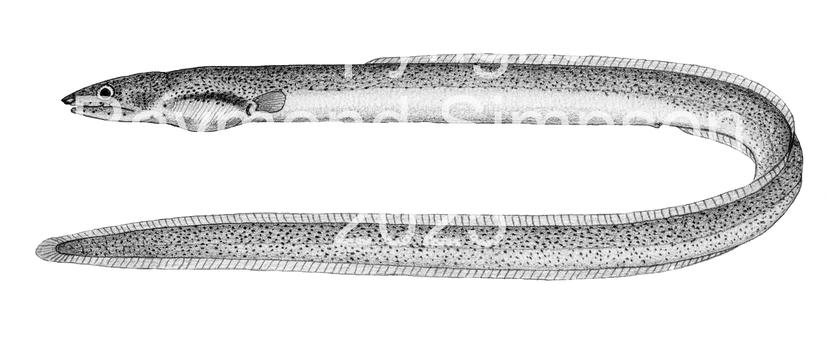
Common Name
Broadnose Worm Eel
Year Described
Breder, 1927
Identification
Vertebrae: 18-22 predorsal, 46-48 pre-anal, 140-146 total
Body elongate and laterally compressed. Trunk shorter than tail. Snout short, bluntly rounded and overhangs mouth. Eye over middle of jaw. Underside of snout without groove. Anterior nostril a well developed tube. Posterior nostril a small slit in upper lip under anterior eye. Teeth small and conical. Two rows of teeth on maxillary (19-31 outer, 11-14 inner)) and dentary (23-36 outer and 6-10 inner). Intermaxillary teeth present (9-10) in a rounded patch connected to vomerine row. Vomer with one row of teeth (14-18). Gill openings small on lower side. Dorsal fin origin well behind gill slit (halfway between snout tip and anus). Anal fin present. Dorsal and anal fins low and continuous around the tail. Anal fin higher than dorsal fin. Pectoral fin well developed (2X orbit) and rounded. Lateral line complete with only anterior pores easily visible. Head pores well developed. Two postorbital pores
Color
Larger specimens pale yellow with a white belly. Dorsal head and body with a heavy peppering of large melanophores. Fins unmarked. Young fish pale yellow with white belly finer speckling.
Size
Maximum size to 208mm TL.
Habitat
Found over a range of depth (0-220m) but more common in shallow coastal waters <10m. Burrows in sand or mud in calm waters.
Range
Bermuda, S. Florida to S. Brazil, the Gulf of Mexico and the Caribbean islands.
References
Böhlke, E. B. (ed.). 1989. Volume One: Orders Anguilliformes and Saccopharyngiformes. Volume Two: Leptocephali. Fishes of the western North Atlantic. Memoirs of the Sears Foundation of Marine Research Mem. 1 (part 9): v. 1:i-xvii + 1-655; 2:i-vii + 657-1055.
Other Notes
The four W. Atlantic Myrophis are distinguished by dorsal fin origin position and vertebral counts. M. anterodorsalis and platyrhynchus are both small species but platyrhynchus has two postorbital pores.